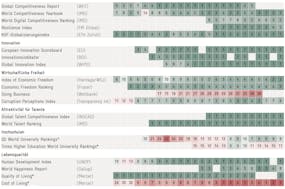Unprecedented in its scope, the Corona pandemic has prompted a plethora of reactions among governments internationally.
But irrespective of the length or severity of their lockdowns, their willingness or reluctance to close borders, or their thresholds for proof of vaccination, one strategy has proved relatively commonplace. Around the world, governments have intervened to support jobs and prevent mass unemployment.
So far, academic studies on the economic and societal impact of such schemes – whether macroeconomic distortions, wage inflation or attitudes towards working from home, have been rare.
Two main reasons explain the absence of more research. Uncertainties about the starting and end points of pandemic induced market distortions complicate any serious study. Is the crisis largely over now, or is a new wave already on the horizon? If so, what’s the point of crunching the numbers yet?
Secondly, and somewhat linked, is a lack of solid data. The pandemic moved gradually westwards, but not even China suffered for all of 2020. If the focus instead is on this year, fully 2021 data on employment and wages is not yet available.
Despite such limitations, work on the macroeconomic and narrower labour market implications of Covid-19 remains instructive. How timely then that Marco Salvi and Valérie Müller, two Avenir Suisse researchers, have turned their attention to the effects on Switzerland.
The country has – so far – had a relatively ‘good’ crisis, economically speaking. The federal government’s decision to avoid the fiercer lockdowns imposed by many neighbours limited the damage to the domestic economy (even if Switzerland, with its export orientated economy, remained vulnerable to slowdowns elsewhere). And the relative preponderance of ‘defensive’ sectors like pharmaceuticals and chemicals, and, to a lesser extent, capital goods, played a part.
Nevertheless, Switzerland’s experience has been sufficiently traumatic to warrant deeper study, whether in terms of the groups and sectors most affected, or the deflationary (and then potentially inflationary) pressures on wages. Broader themes also come into play, such as the effect on labour market participation or attitudes to work in general.
Were some sectors more affected than others? Women more than men? Or students more inclined to prolong their studies? And what are the longer term changes now required – for example in labour law or social security rules?
Salvi and Müller offer many suggestions. While recognising data limitations, they confirm the more circumstantial evidence already circulating. While the economic impact of Switzerland’s Covid-19 exposure was, indeed, relatively mild compared with most nations, up to a quarter of the total workforce nevertheless went on government wage support schemes.
But the labor market participation rate barely dipped, while the rise in unemployment – of just 0.8 percentage points last year – was comparatively mild, even against the relatively sharp 3.7 percent contraction in the total number of hours worked. And in terms of wage inflation, the Swiss data show a real rise of 1.5 percent last year, but little sign – so far – of any worrying surge in inflationary wage expectations.
Aggregated by category, young adults, the self-employed and those in lower paid white collar jobs were worst hit. Unsurprisingly, the hospitality sector suffered especially badly, with a 30 percent drop in total working hours.
Interestingly, however, the research shows that women – whose participation in the labor market is traditionally more volatile and whose earnings are generally concentrated in the lower echelons of the salary scale – were not particularly affected – even if the data confirms existing findings that female labor is, generally speaking, more vulnerable to economic fluctuations than men’s.
Of course, all came at a cost. The Swiss government spent billions on wage support, let alone the vast amounts committed to loan guarantees (and sometimes direct subsidies) to individual companies or sectors. State wage subsidies protected about 120,000 jobs. But without them, unemployment would have jumped to around 5.5 percent, compared with 3.3 percent (as measured by Swiss standards).
From, a liberal economic perspective, however, the authors argue the enough is enough. They single out the extension to the duration (and extent for lower earners) of the wage support scheme, and the extension of unemployment benefit, as unwelcome developments – however unprecedented the crisis. A swift return to pre-Covid-19 normality is their considered solution.





